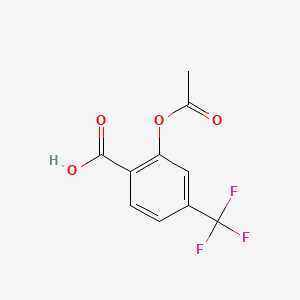



1. 2-acetoxy-4-trifluoromethylbenzoic Acid
2. Disgren
1. 322-79-2
2. 2-acetoxy-4-trifluoromethylbenzoic Acid
3. Disgren
4. 2-acetoxy-4-(trifluoromethyl)benzoic Acid
5. 2-acetyloxy-4-(trifluoromethyl)benzoic Acid
6. Triflusal [inn]
7. 2-(acetyloxy)-4-(trifluoromethyl)benzoic Acid
8. Benzoic Acid, 2-(acetyloxy)-4-(trifluoromethyl)-
9. 1z0yfi05oo
10. Triflusal (inn)
11. Ncgc00016431-01
12. 2-acetoxy-4-trifluoromethyl-benzoic Acid
13. Cas-322-79-2
14. Triflusalum
15. Grendis
16. Aflen
17. Triflusalum [inn-latin]
18. Ur 1501
19. Drisgen
20. Triflusal [inn:ban]
21. Einecs 206-297-5
22. Unii-1z0yfi05oo
23. 4-trifluoromethylsalicylic Acid Acetate
24. Brn 2945374
25. Tecnosal
26. Triflux
27. Alpha,alpha,alpha-trifluoro-2,4-cresotic Acid Acetate
28. Prestwick_851
29. Alpha,alpha,alpha-trifluoro-2,4-creosotic Acid Acetate
30. Triflusal [mi]
31. Prestwick0_000528
32. Prestwick1_000528
33. Prestwick2_000528
34. Prestwick3_000528
35. Triflusal [mart.]
36. Triflusal [who-dd]
37. Dsstox_cid_25305
38. Dsstox_rid_80791
39. Dsstox_gsid_45305
40. Bspbio_000515
41. 4-10-00-00619 (beilstein Handbook Reference)
42. Schembl136423
43. 3-acetoxy-alpha,alpha,alpha-trifluoro-p-toluic Acid
44. Spbio_002436
45. Bpbio1_000567
46. Zinc2220
47. Chembl1332032
48. Dtxsid8045305
49. Triflusal [ep Monograph]
50. Chebi:94721
51. 2,4-cresotic Acid, Alpha,alpha,alpha-trifluoro-, Acetate
52. Hms1569j17
53. Hms2096j17
54. Hms3652m11
55. Hms3713j17
56. Hms3885i13
57. Bcp10024
58. Hy-b0531
59. Tox21_110436
60. Mfcd00866793
61. S3200
62. Ur1501
63. Akos015890393
64. Ac-1829
65. Ccg-220528
66. Ccg-222319
67. Db08814
68. Mb01536
69. Ur-1501
70. 2-acetoxy-4-trifluoromethyl Benzoic Acid
71. Acetyl-4-(trifluoromethyl)salicylic Acid
72. Ncgc00016431-02
73. Ncgc00016431-04
74. Ncgc00016431-11
75. As-63983
76. A5797
77. B1461
78. Ft-0601555
79. Sw196982-3
80. T3601
81. D07142
82. T72290
83. 322t792
84. Sr-01000872666
85. Q1758668
86. Sr-01000872666-1
87. W-106849
88. Brd-k71696703-001-01-2
| Molecular Weight | 248.15 g/mol |
|---|---|
| Molecular Formula | C10H7F3O4 |
| XLogP3 | 2.1 |
| Hydrogen Bond Donor Count | 1 |
| Hydrogen Bond Acceptor Count | 7 |
| Rotatable Bond Count | 3 |
| Exact Mass | 248.02964319 g/mol |
| Monoisotopic Mass | 248.02964319 g/mol |
| Topological Polar Surface Area | 63.6 Ų |
| Heavy Atom Count | 17 |
| Formal Charge | 0 |
| Complexity | 313 |
| Isotope Atom Count | 0 |
| Defined Atom Stereocenter Count | 0 |
| Undefined Atom Stereocenter Count | 0 |
| Defined Bond Stereocenter Count | 0 |
| Undefined Bond Stereocenter Count | 0 |
| Covalently Bonded Unit Count | 1 |
Triflusal is indicated as prophylaxis of thromboembolic disorders. It has been registered in Spain and in other countries of Europe, South America and South Korea for the prevention of Stroke and myocardial infarction.
Triflusal is an antithrombotic anticoagulant. It irreversibly inhibits the production of thromboxane-B2 in platelets by acetylating cycloxygenase-1. Triflusal affects many other targets such as NF kappa B, which is a gene expression regulatory factor for cycloxygenase-a and cytokines. Numerous studies comparing the efficacy and safety profile (i.e. systemic hemorrhage) between triflusal and acetylsalsylic acid has shown either no significant difference or a better effacy and safety profile for triflusal. Triflusal has been shown to protect cerebral tissue due to its inhibition of lipid peroxidation resulting from anoxia-reoxygenation.
Platelet Aggregation Inhibitors
Drugs or agents which antagonize or impair any mechanism leading to blood platelet aggregation, whether during the phases of activation and shape change or following the dense-granule release reaction and stimulation of the prostaglandin-thromboxane system. (See all compounds classified as Platelet Aggregation Inhibitors.)
B - Blood and blood forming organs
B01 - Antithrombotic agents
B01A - Antithrombotic agents
B01AC - Platelet aggregation inhibitors excl. heparin
B01AC18 - Triflusal
Absorption
Absorbed in the small intestine with a bioavailability range from 83% to 100%. There is no significant difference between the absorption of the oral solution and capsule formulation. Triflusal displays a Cmax of 11.6 mcg/ml and a tmax of 0.88 h. The major metabolite of triflusal presents different pharmacokinetic properties by showing a Cmax and tmax of 92.7 mcg/ml and 4.96 h, respectively.
Route of Elimination
The elimination pathway of triflusal is primarily renal. Urine analysis has shown the presence of unchanged triflusal, HTB and the glycine conjugate of HTB.
Volume of Distribution
The reported volume of distribution for triflusal is of 34L.
Clearance
Renal clearance is 0.8 +/- 0.2L/h and 0.18 +/1 0.04L/h for triflusal and HTB, respectively.
In the liver, triflusal undergoes deacetylation, forming its main metabolite 2-OH-4-trifluoromethyl benzoic acid (HTB). This major metabolite seems to have marked antiplatelet properties in vitro.
In the healthy human, the half-life is 0.5 +/- 0.1h, while that of HTB is 34.3 +/- 5.3h.
Triflusal is chemically related to acetylsalicylic acid (ASA) and irreversibly inhibits cycloxygenase-1 (COX-1) in platelets. Acetylation of the active group of COX-1 prevents the formation of thromboxane-B2 in platelets. However, it is unique because it spares the arachidonic acid metabolic pathway in endothelial cells. In addition, it favors the production of nitric oxide, a vasodilator.